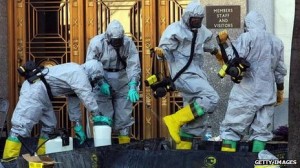Cross-posted from the BBC
By Katia Moskvitch Technology reporter, BBC News, Cambridge
A UN official delivered the warning at the BioDesign Forum on synthetic biology being held in the UK.
Piers Millet from the UN’s Biological Weapons Convention said there was no global organisation to ensure biotech was not used for “nefarious” purposes.
But international bodies did exist to watch out for nuclear and chemical weapons, he told the Cambridge meeting.
“If you look at the history of the last century we see a very clear trend – every time we make a major step forward in our understanding of biology, we find a weapons application for it,” he said.
He listed several major cases of biological attacks in the past few decades, such as the doomsday Aum Shinrikyo cult spraying anthrax spores from the roof of an eight-storey building in Tokyo, Japan, in 1993.
 There are regular military exercises training people to respond to a chemical or biological attack
There are regular military exercises training people to respond to a chemical or biological attackThe city was subjected to another attack from the same religious group two years later, when sarin gas was released on the Tokyo subway system, causing 12 deaths.
Biological weapons were used as early as the 18th Century, when Britain infected tribes of Native Americans with smallpox.
More recently, said Mr Millet, there had been instances of biological weapons in World War II and during the Gulf War in 1991 in Iraq.
‘Strong models’
“The traditional approach of the international community to dealing with weapons is this – they recognise a threat, develop a treaty, and then they turn that treaty into some operational form, normally by trying to control technology associated with it,” he said.
“It has very strong models in nuclear and chemical spheres – but not in regards to synthetic biology.”
Mr Millet explained that in the case of nuclear warfare, the International Atomic Energy Agency verified whether a nation possessed plutonium, and whether its uranium was enriched to the point that it could be used for military purposes.
“Start Quote
With the advancement of synthetic biology, it becomes possible to do dangerous things”
Prof Tom KnightMIT
Regarding potential chemical weapons production, there is the Organisation for the Prohibition of Chemical Weapons.
Its officials visited the facilities around the world where such weapons could be made and “can easily make sure that the stuff going into a particular process roughly matches the stuff coming out in the end”, said Mr Millet.
“This is done so that you can be pretty certain that large amounts are not being diverted for other purposes.”
But there was no international organisation to do this in the biological arena, he added.
Mr Millet summarised the main points of the existing biological weapons convention:
- States that sign it say that they will never acquire or use biological or toxic weapons.
- They will never assist anybody else in acquiring or using those weapons.
- They bind themselves to take effective national measures to both prohibit and prevent people from dong it.
- And they do so in all the way that promotes the peaceful use of biology.
“This balances security with the legal right to access for peaceful use,” said Mr Millet.
 It is already possible to create an influenza virus in the lab
It is already possible to create an influenza virus in the lab“There is quite a big push to enforce this at the international level, to set up some technology-based control regime in the biological arena.
“I personally believe this is doable.”
Important balance
Prof Tom Knight, a research scientist at the Massachussets Institute of Technology who is referred to by many in the scientific community as “the father of synthetic biology,” said that there was “a race going on between people who try to do bad things, and the ability to use the technology to counter those threats.
“With the advancement of synthetic biology, it becomes possible to do dangerous things – but it also becomes possible to respond to those more rapidly, more effectively, with advanced technology.”
Another speaker at the event, Prof Derek Smith from the department of zoology at the University of Cambridge, said that it was important to consider the benefits of biotechnology as well as its threats.
He and his colleagues work on trying to predict the evolution of seasonal influenza to make better flu vaccines – and recently, he has been involved in a project with scientists in Japan aiming to create influenza viruses in a lab.
“There is a balance to be made between the security concerns of humans being able to make these viruses with public health benefits and the security reduction of knowing what those viruses would look like,” he said, “because this would allow us to know how to better mitigate to reduce the probability of those viruses actually evolving in nature.”